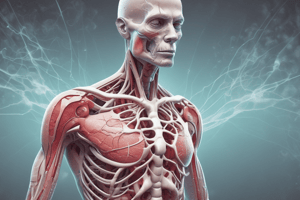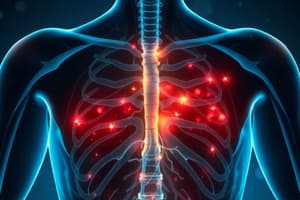Podcast
Questions and Answers
A patient presents with hypocalcemia due to the removal of their parathyroid gland. Which of the following mechanisms is the most direct cause of their condition?
A patient presents with hypocalcemia due to the removal of their parathyroid gland. Which of the following mechanisms is the most direct cause of their condition?
- Decreased parathyroid hormone leading to reduced calcium resorption from the bone. (correct)
- Increased binding of calcium to albumin due to alkalosis.
- Reduced absorption of calcium in the intestines due to decreased vitamin D activation.
- Decreased calcitonin secretion leading to increased osteoclast activity.
A patient with chronic alcoholism is admitted with hypomagnesemia. How does this electrolyte imbalance contribute to hypocalcemia?
A patient with chronic alcoholism is admitted with hypomagnesemia. How does this electrolyte imbalance contribute to hypocalcemia?
- Low magnesium levels enhance the effects of vitamin D, leading to decreased calcium absorption.
- Magnesium deficiency causes increased deposition of calcium in soft tissues.
- Hypomagnesemia directly increases calcium excretion by the kidneys.
- Hypomagnesemia impairs the production or action of parathyroid hormone. (correct)
A patient is experiencing respiratory acidosis. Which of the following compensatory mechanisms would the body employ to restore acid-base balance?
A patient is experiencing respiratory acidosis. Which of the following compensatory mechanisms would the body employ to restore acid-base balance?
- Increased respiratory rate to eliminate $CO_2$. (correct)
- Decreased reabsorption of $H^+$ by the kidneys.
- Increased excretion of bicarbonate ($HCO_3$) by the kidneys.
- Decreased respiratory rate to retain more $CO_2$.
A patient presents with metabolic alkalosis due to excessive vomiting. Which of the following represents the most appropriate compensatory response by the body?
A patient presents with metabolic alkalosis due to excessive vomiting. Which of the following represents the most appropriate compensatory response by the body?
A patient with uncontrolled diabetes mellitus develops ketoacidosis. The patient starts exhibiting Kussmaul breathing. What is the physiological purpose of this respiratory pattern?
A patient with uncontrolled diabetes mellitus develops ketoacidosis. The patient starts exhibiting Kussmaul breathing. What is the physiological purpose of this respiratory pattern?
Flashcards
Hypocalcemia
Hypocalcemia
Low calcium levels in the blood, potentially causing seizures and cardiac issues.
Hypercalcemia
Hypercalcemia
High calcium levels in the blood, possibly leading to encephalitis and life-threatening crisis.
Respiratory Acidosis
Respiratory Acidosis
Inadequate alveolar ventilation leading to decreased pH and increased CO2.
Respiratory Alkalosis
Respiratory Alkalosis
Signup and view all the flashcards
Metabolic Acidosis
Metabolic Acidosis
Signup and view all the flashcards
Study Notes
- Calcium levels should be between 9-11.
Hypocalcemia
- Decreased parathyroid hormone can result in injury or removal of the parathyroid.
- Hypomagnesemia inhibits parathyroid action.
- Alkalosis enhances calcium binding to albumin.
- Low Vitamin D reduces calcium absorption.
- Calcitonin prevents osteoclast function.
- Pancreatitis causes calcium to deposit in the abdomen.
- Hypocalcemia can result in life-threatening seizures and fatal cardiac dysrhythmias.
Hypercalcemia
- Excessive parathyroid hormone can result in malignancy or hyperparathyroidism.
- Acidosis reduces binding to albumin.
- Hypervitaminosis D increases calcium absorption.
- Hypercalcemia can result in encephalitis in >14 individuals and is potentially life-threatening and causes crisis in >15 individuals.
Respiratory Acidosis
- Inadequate alveolar ventilation results in a decrease in pH and an increase in CO2, resulting in an increase in H+ in the blood.
- The body compensates by kidneys increasing H+ excretion and reabsorbing HCO3 and increasing respiratory rate (RR) to remove CO2.
Respiratory Alkalosis
- Hyperventilation increases pH and decreases CO2, resulting in a decrease in H+ in the blood.
- The body compensates by decreasing respiratory rate (RR) and kidneys decreasing H+ excretion and absorption of HCO3.
Metabolic Acidosis
- Renal and GI issues like HCO3 loss, acid ingestion and alterations in acid production decrease pH and HCO3, increasing H+ in the blood.
- Compensation occurs through hyperventilation/Kussmaul breathing (rapid, deep breathing).
Metabolic Alkalosis
- Renal and GI issues like H+ loss, intracellular shift of H+, and retention of HCO3 increase pH and HCO3, resulting in decreased H+ in the blood.
- Compensation occurs through hypoventilation.
Studying That Suits You
Use AI to generate personalized quizzes and flashcards to suit your learning preferences.




